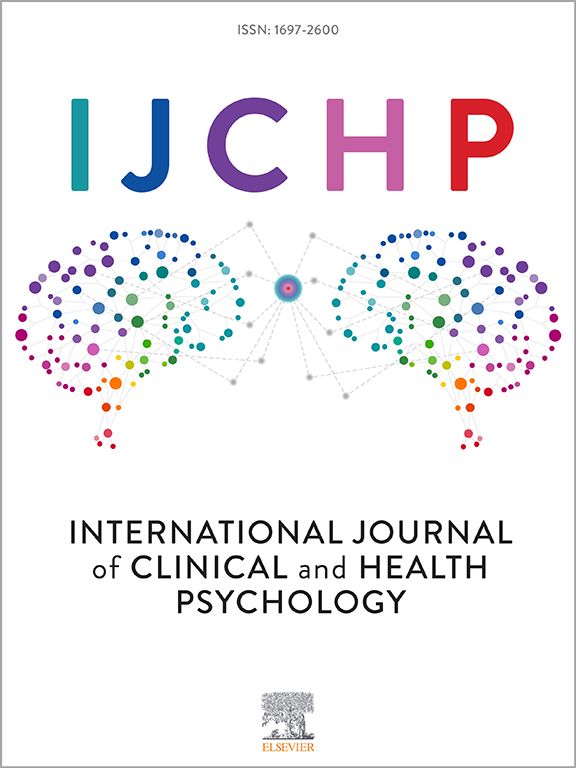Do expectations shape interoceptive perceptions across body domains? A sham EMF study to test the predictive processing theory
IF 4.4
1区 心理学
Q1 PSYCHOLOGY, CLINICAL
International Journal of Clinical and Health Psychology
Pub Date : 2025-07-01
DOI:10.1016/j.ijchp.2025.100609
引用次数: 0
Abstract
Objective
According to the principles of predictive processing theory, persistent symptom perception is largely determined by central nervous predictions on somatosensory input. Here, we examine how threat-related expectations shape predictions and interoceptive perceptions across body domains using sham EMF (electromagnetic field) exposure.
Methods
Participants (n = 113) were recruited via announcements at the university. Most participants were female (76.1 %) with a mean age of 25.12 years. Participants were divided into two groups (sham EMF on/off). Both groups completed a somatic and a cardiovascular signal detection task (SSDT, cvSDT) in pseudo-randomized order. Sensitivities and response biases were calculated. Self-reports (symptom distress, anxiety) were completed. Group effects were analysed with (M)AN(C)OVAs. In four exploratory regression models response bias and anxiety (state/trait) served as predictors for somatic symptom distress.
Results
Participants in the sham EMF group reported significantly higher levels of state anxiety (p = .021, d = 0.44) and, trend-wise, more symptoms during the experiment (p = .065, d = 0.35). Response biases did not differ significantly between the groups (SSDT: p = .782; cvSDT: p = .743). However, higher somatic symptom distress was significantly associated with a more liberal interoceptive response tendency in both tasks in the sham EMF group (two significant models, one trend: (-0.209 ≤ βs ≤ -0.325, adjusted 0.232 ≤ R² ≤ 0.330).
Conclusions
A liberal approach was associated with elevated symptom experience across bodily domains and might be considered a transdiagnostic psychopathological risk factor. As research is still scarce, replication studies with valid context manipulations are essential.
期望是否会影响跨身体域的内感受性知觉?假电动势研究,以检验预测加工理论
目的根据预测加工理论的原理,持续症状知觉在很大程度上是由中枢神经对躯体感觉输入的预测决定的。在这里,我们研究了与威胁相关的期望如何通过假电磁场暴露来塑造身体各领域的预测和内感受性感知。方法通过大学公告招募参与者(n = 113)。大多数参与者为女性(76.1%),平均年龄为25.12岁。参与者被分为两组(假EMF开/关)。两组均按伪随机顺序完成躯体和心血管信号检测任务(SSDT, cvSDT)。计算灵敏度和反应偏差。完成自我报告(症状困扰、焦虑)。用(M)AN(C) ova分析组效应。在四个探索性回归模型中,反应偏倚和焦虑(状态/特质)可作为躯体症状困扰的预测因子。结果假EMF组的参与者报告了更高水平的状态焦虑(p = 0.021, d = 0.44),并且在实验期间出现了更多的症状(p = 0.065, d = 0.35)。两组间反应偏倚无显著差异(SSDT: p = .782;cvSDT: p = .743)。然而,更高的躯体症状困扰与假EMF组在两个任务中更自由的内感受性反应倾向显著相关(两个显著模型,一个趋势:(-0.209≤βs≤-0.325,调整后的0.232≤R²≤0.330)。结论自由入路与跨身体领域的症状体验升高有关,可能被认为是一种跨诊断的精神病理危险因素。由于研究仍然稀缺,具有有效背景操作的复制研究是必不可少的。
本文章由计算机程序翻译,如有差异,请以英文原文为准。
求助全文
约1分钟内获得全文
求助全文
来源期刊

International Journal of Clinical and Health Psychology
PSYCHOLOGY, CLINICAL-
CiteScore
10.70
自引率
5.70%
发文量
38
审稿时长
33 days
期刊介绍:
The International Journal of Clinical and Health Psychology is dedicated to publishing manuscripts with a strong emphasis on both basic and applied research, encompassing experimental, clinical, and theoretical contributions that advance the fields of Clinical and Health Psychology. With a focus on four core domains—clinical psychology and psychotherapy, psychopathology, health psychology, and clinical neurosciences—the IJCHP seeks to provide a comprehensive platform for scholarly discourse and innovation. The journal accepts Original Articles (empirical studies) and Review Articles. Manuscripts submitted to IJCHP should be original and not previously published or under consideration elsewhere. All signing authors must unanimously agree on the submitted version of the manuscript. By submitting their work, authors agree to transfer their copyrights to the Journal for the duration of the editorial process.
 求助内容:
求助内容: 应助结果提醒方式:
应助结果提醒方式:


